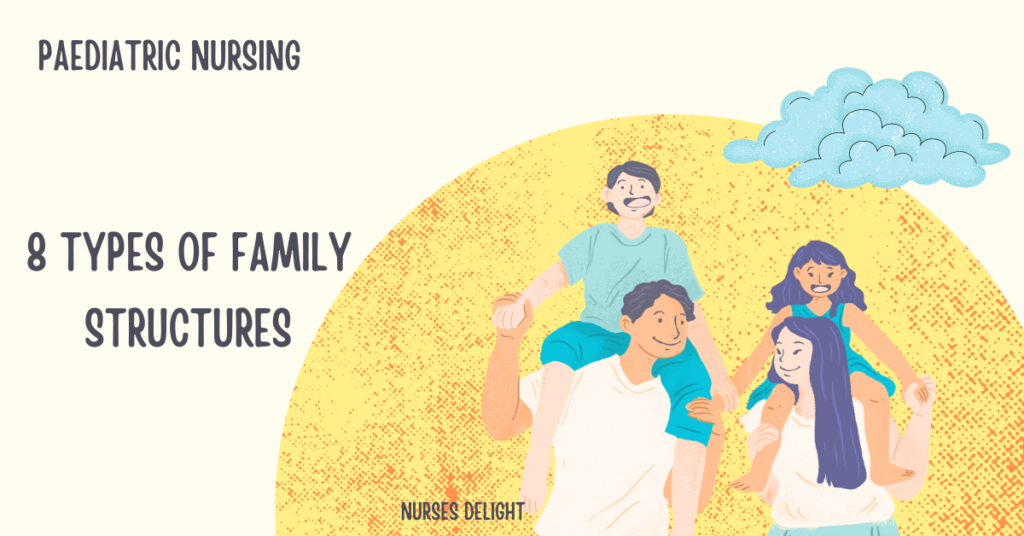A family is a structure of interpersonal relationships that offer the material and psychological support necessary for social functioning.
Family bonds are not limited to blood relations.
As a nurse looking for children, you may face a different set of difficulties depending on the kind of family. Remember to inquire about household members when taking a pediatric history. The known types of families that you should be aware of include;
- Nuclear families
- Binuclear families
- Blended families
- Cohabitation families
- Extended families
- Single-parent families
- Communal families
- Foster families
Nuclear Family
A nuclear family is also known as a traditional family, conjugal family, or elementary family.
It consists of spouses and their child or children (biological or adopted). The members of a nuclear family share financial commitments, tasks, and responsibilities, and the family functions as a support system for each other. However, some nuclear families may lack the additional support needed during challenging times.
Binuclear Family
As more parents remarry and share custody and upbringing of their children, binuclear families are becoming increasingly prevalent.
Parental divorce results in the creation of the binuclear family, which consists of two distinct but connected houses that were once the child’s (children’s) family.
Blended Family
It comprises married couples with children from previous relationships.
A blended family permits role sharing and emotional support. It also gives the family members a chance to practice cooperation and find innovative methods for completing tasks.
While financial obligations can be split, there may be tension if one adult must continue to support their former spouse, their children, or both.
Cohabitation Family
A cohabitation family is a nuclear family consisting of two parents and one or more children, with no marriage between the adults. Members of this family type receive both material and emotional support. But, there’s a chance that one person will take the partner’s apparent or actual lack of commitment as a threat.
An Extended Family
It is also called a multigenerational family.
It comprises a child or children, a minimum of one parent, and any mix of grandparents, aunts, uncles, or cousins. Support in this family type comes from the group.
However, conflict over roles—such as who should make decisions about the child’s care or which adult is considered the child’s mother or father—may emerge in an extended family, which could be a drawback.
A Single-Parent Family
It consists of one parent and their child(ren) living together at home. A growing number of families are headed by a single parent due to reasons like rising divorce rates.
The parent and child in a single-parent household are each other’s main sources of support. Although this can strengthen relationships, it can also put stress on the single parent in terms of fulfilling their parental responsibilities. Childcare issues may arise if the child is sick. In addition, financial limitations resulting from low income could exist.
Having to handle every aspect of parenting children on their own can wear a single parent out. Because a single parent tries—and sometimes fails—to provide their child everything that some two-parent households are able to supply, single parenting can also result in low self-esteem.
Communal Family
In a communal family, people decide to live with a group of people who are not related to them and who end up being the extended family. Usually, religious convictions or social ideals are the basis of the connection. Typically, the group leader assumes the role of a parent, making decisions on behalf of the child. One drawback of this family structure is the inclination to treat medical issues within the group rather than contacting outside professionals for assistance with health-related issues.
Foster Families
An adopted or biological parent who is unable to care for their child can be placed with a foster family. Foster parents might or might not be connected to the foster child. Kinship care is the term typically used to describe a placement where the foster parents are related to the kid. Ideally, foster care is provided temporarily until the biological or adoptive parent can resume their role. Sadly, a foster child may be moved around from foster home to foster home, missing out on the stability that comes from spending a significant amount of time with the same family (biological, adoptive, or foster). Determining who has the authority to make decisions regarding the foster child’s medical treatment can sometimes be challenging.
In conclusion, understanding the diverse array of family structures is crucial for healthcare professionals, especially nurses, as they navigate the complexities of providing care to children.
Each family type presents unique challenges and strengths, influencing the dynamics of support and cooperation within the unit. Acknowledging the existence of nuclear families, binuclear families, blended families, cohabitation families, extended families, single-parent families, communal families, and foster families enables healthcare practitioners to approach pediatric care with sensitivity and tailored support.
By recognizing the variations in family compositions, nurses can better address the specific needs of children and foster effective communication with caregivers. Embracing this inclusive perspective not only enhances the quality of healthcare but also contributes to the overall well-being of the families under their care.




I like the way you explain on this
May God bless you and protect you.
Thank You so much Cosmas